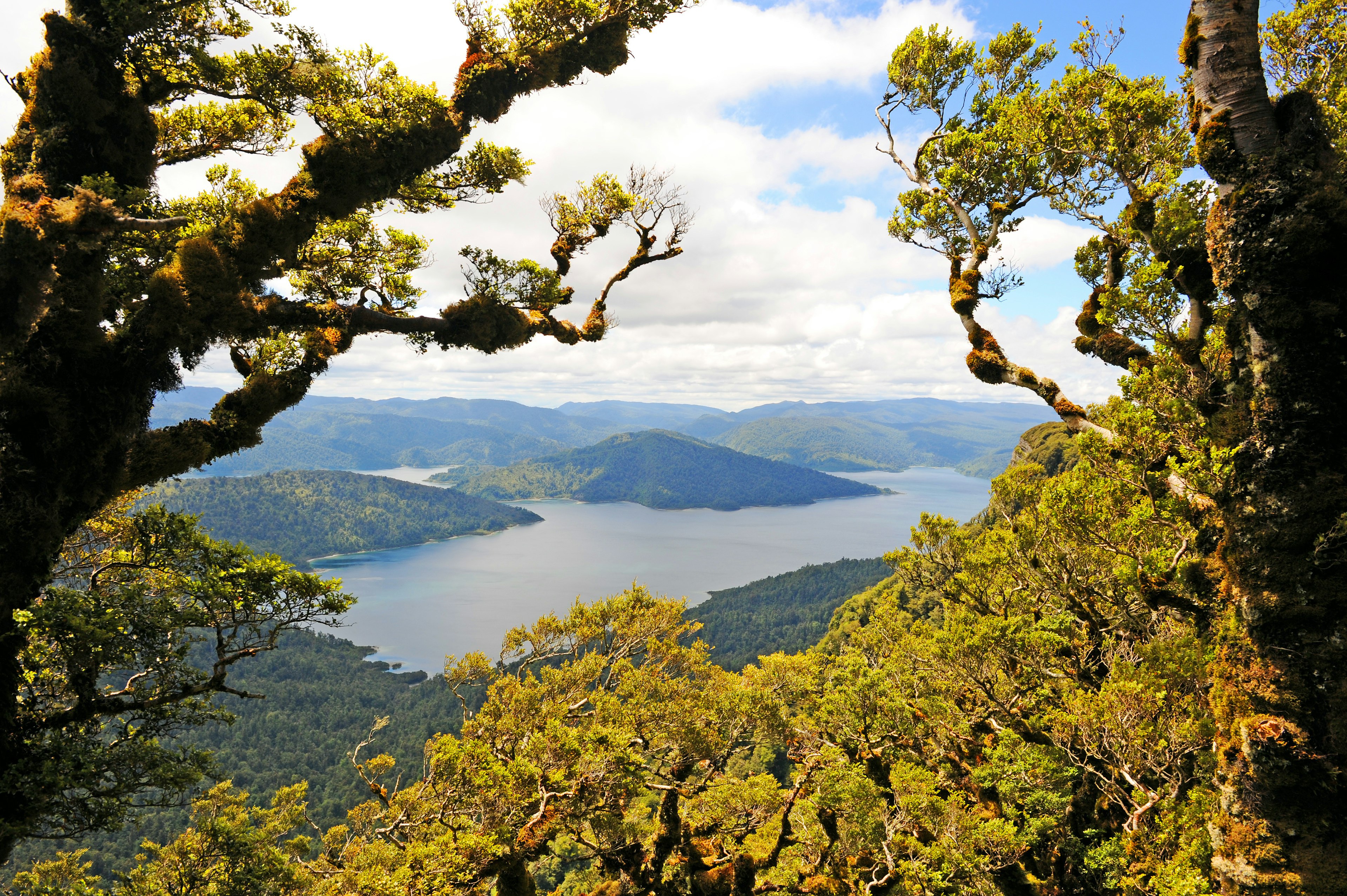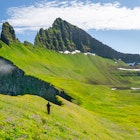
New Zealand has a new Great Walk, and bookings are about to open

May 20, 2024 • 7 min read

The Hump Ridge Track is New Zealand's newest Great Walk © Jessica Wynne Lockhart / Lonely Planet
I started my morning along a wide swath of sandy beach, nary another soul in sight, before climbing high into the mountains through goblin-like forests. Around me, everything was a million shades of green, save for the occasional burst of color: electric-blue mushrooms; neon orange lichen; and the red underside of a kākā’s wings as it swooped down low beside my head. Finally emerging above the treeline, I was rewarded with 360-degree views of one of New Zealand’s most remote and jaw-droppingly beautiful corners: Fiordland National Park.
I was trialing the 61km (38-mile) Hump Ridge Track, which will become New Zealand’s newest Great Walk in October 2024 once upgrades are complete – only the second to be added to the renowned hiking collection in about 30 years.
New Zealand’s Great Walks are considered the country’s most iconic multiday treks, but hiking one is harder than just showing up. It takes planning, with bookings on the most popular routes selling-out within minutes. (In 2023, the bookings system crashed when 10,000 people logged on at the same time, most vying for a spot on the 53.5km/33-mile Milford Track.)
That’s not to say it’s impossible. If you’re planning a trip to New Zealand, here’s everything you need to know about the Great Walks, including the new Hump Ridge Track and the perennially popular Milford Track.

What are New Zealand's Great Walks?
Managed by the Department of Conservation (DOC), the Great Walks are a collection of 11 multiday hikes (called “tramps” in Kiwi) that showcase the diversity of New Zealand’s landscape, from volcanic plateaus to golden-hued beaches.
They’re also amongst the most accessible backcountry experiences in Aotearoa (the Māori language name for New Zealand). Trails are easy to follow, with hikers staying in huts – staffed by wardens and equipped with shared bunk rooms, kitchens and outhouses – along the way, although camping is also an option on some of the trails.
Their popularity, length and difficulty vary, with most lasting for between three and five days. Strangely, some aren’t even "walks" at all. The Whanganui Journey, in the central North Island, is a canoe trip. Meanwhile, mountain biking is permitted on the West Coast’s Paparoa Track and Kahurangi National Park’s Heaphy Track.

How can I book a Great Walk?
The process for scoring a spot isn’t unlike trying to get Taylor Swift tickets. You need to be prepared and it helps to have more than one member of your party on the case. The first step is to sign-up for a DOC account. Then, mark your calendar for the booking day.
In 2024, bookings will open for the Great Walk Season (which runs from roughly October 2024 to April 2025) on the following dates:
May 28 at 9:30am NZST: Milford Track, Lake Waikaremoana Track
May 30 at 9:30am NZST: Abel Tasman Coast Track, Rakiura Track, Whanganui Journey
June 5 at 9:30am NZST: Routeburn Track, Paparoa Track
June 6 at 9:30am NZST: Kepler Track, Heaphy Track, Tongariro Northern Circuit
On the day bookings open for your walk of choice, be logged in and ready. You’ll need to have a form of payment and know the names, ages, and country of residence for each hiker in your group.
There is one exception to this rule, which is the Hump Ridge Track. Bookings can be made directly on the walk’s dedicated website up to a year in advance.

Are there any insider secrets to scoring a Great Walk spot?
Being flexible on when you want to travel helps, but there are a few other tricks to nabbing a spot.
First, choose your dates carefully. Kiwis love tramping, so bookings during the summer school holiday period – which runs from late December until early February – are amongst the most sought-after. For the best weather and availability, try early December or March instead.
Counterintuitively, it can also be better to try booking a couple of hours after DOC’s system opens. In order to ensure their spot, multiple people in the same hiking party will often make a booking for their entire group. That means they’ll have to go back later – often that same day – to cancel one of the duplicate bookings.
Spots can also open up later in the season. Members of the very active Tramping in New Zealand Facebook group will post if they cancel a booking, alerting other members to available dates in the system.
Finally, if your budget allows, you can choose to forgo the booking day frenzy altogether. Tour operators such as Ultimate Hikes offer guided Great Walks experiences on the Milford and Routeburn Tracks, with packages that include accommodation at private lodges, meals, transfers and the use of a 40L backpack. You’ll pay for the ease of booking, though. Ultimate Hikes charges upwards of NZD$2700, while the independent hikers on the same tracks will pay less than NZD$500 for huts and transfers.

What’s the new Hump Ridge Track like? And is the Milford Track really worth the hype?
We’re glad you asked. Both tracks go through the wilds of Fiordland National Park, so it’s hard not to draw comparisons. However, the two are markedly different experiences.
The Milford Track’s title of the “finest walk in the world” is entirely justified. Stunningly beautiful in its wild isolation, it carries hikers through valleys and over mountain passes, where hundreds of waterfalls cascade off the surrounding rock faces on a rainy day. Hikers arrive on their fourth day into Milford Sound/Piopiotahi, a fiord of towering peaks that attracts up to a million visitors annually.
But it’s also the hardest track to get a booking on. So, if you have your heart set on exploring Fiordland, the community-owned Hump Ridge Track is a great alternative. It’s set in a subalpine environment favored by kākā and kea (endemic parrots). With epic ocean views – including of Stewart Island/Rakiura – boardwalks trace the ridgelines before descending into forests that drip in moss.
Other highlights include walking across the longest viaduct in the southern hemisphere, and the opportunity to swim with wild Hector’s dolphins at Port Craig, a ghost town where you’ll spend your second night. There are also some splash-out worthy upgrades on offer: we’re talking private rooms with real beds, hot showers, flush toilets, and even the option to get your pack helicoptered up to the first hut.

I didn’t get a Great Walk booking. What are some alternative hikes?
If you’ve missed out on booking a Great Walk this year, there are two other beginner-friendly ways to experience New Zealand’s backcountry.
Try a Great Walk day hike instead
With the help of local tour operators and transfer services, it’s possible to experience a short portion of a Great Walk, with the added benefit that you won’t have to schlep your stuff.
For example, the Tongariro Alpine Crossing – arguably the country’s best single-day hike – is part of the much longer Tongariro Northern Circuit. Or, for one of the most scenic sections of the Whanganui Journey, take a jet boat from Pipiriki to the Bridge to Nowhere, then paddle back to your starting point.
For walks in Fiordland, family-owned tour operator Trips & Tramps offers a walking package that allows you to get a taste of the Kepler, Routeburn and Milford Tracks over the course of three consecutive days.
Choose a different multi-day walk
There are hundreds of great hikes to do across New Zealand, even if they’re not “great” with a capital “G.”
Some of our favorites include the Coromandel’s two-day Kauaeranga Kauri Trail, the Marlborough Sounds’ Queen Charlotte Track (which nearly became a Great Walk in 2019) and the more challenging Cape Brett Track in Northland.
When can I hike New Zealand’s Great Walks?
The official “Great Walks Season” lasts for the southern hemisphere summer months of October through to April.
It is possible to access some of the Great Walks outside of this season, but only if you’re well-equipped and have extensive backcountry experience. The weather conditions from May to September can be harsh and may include flooding, freezing temperatures, heavy snowfalls and high winds. Huts aren’t staffed or serviced during this time period and bridges may be removed from river crossings.
What do I need to pack for a Great Walk?
Huts along the Great Walks have shared bunk rooms (bring earplugs!) equipped with sleeping mats, outhouses and kitchens with gas stoves and running water.
In addition to suitable footwear and clothing – which includes wet weather gear for notoriously high rainfall areas like the Milford Track – you’ll need to carry a sleeping bag, crockery, and all your food for the duration of your adventure.
Fortunately, outfitters at towns and cities near the trailheads make it easy to source and rent any gear you might need on arrival in New Zealand. Many also offer transfer services to and from trailheads.
For comprehensive information about each Great Walk – including region-specific safety tips, elevation maps, outfitters and suggested packing lists – visit the DOC’s website.
Explore related stories



 Hiking15 epic hikes in Australia and New Zealand among volcanoes, rainforests and more
Hiking15 epic hikes in Australia and New Zealand among volcanoes, rainforests and moreAug 5, 2022 • 12 min read
 HikingSlow travel and long distance hikes: how to embrace the new outdoor travel trends
HikingSlow travel and long distance hikes: how to embrace the new outdoor travel trendsJul 13, 2022 • 8 min read



 Wildlife & NatureHikers face heavy fines for entering New Zealand's quarantined forests
Wildlife & NatureHikers face heavy fines for entering New Zealand's quarantined forestsJan 23, 2020 • 3 min read

